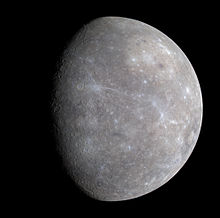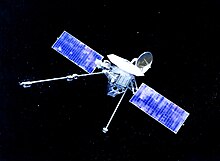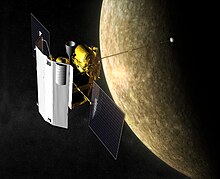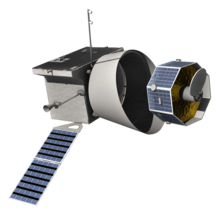Mercury (planet)
Mercury is the smallest planet in the Solar System.[8][9][10] It is the closest planet to the sun.[11] It makes one trip around the Sun once every 87.969 days.[2][12]
 Mercury photographed by MESSENGER spacecraft in 2008 | |||||||||||||
| Designations | |||||||||||||
|---|---|---|---|---|---|---|---|---|---|---|---|---|---|
| Pronunciation | /ˈmɜrkjəri/ ( | ||||||||||||
| Adjectives | Mercurian,[1] | ||||||||||||
| Orbital characteristics[4] | |||||||||||||
| Epoch J2000 | |||||||||||||
| Aphelion | 69,816,900 km 0.466 697 AU | ||||||||||||
| Perihelion | 46,001,200 km 0.307 499 AU | ||||||||||||
| 57,909,100 km 0.387 098 AU | |||||||||||||
| Eccentricity | 0.205 630[2] | ||||||||||||
| 87.969 1 d (0.240 846 a) | |||||||||||||
| 115.88 d[2] | |||||||||||||
Average orbital speed | 47.87 km/s[2] | ||||||||||||
| 174.796° | |||||||||||||
| Inclination | 7.005° to Ecliptic 3.38° to Sun’s equator 6.34° to Invariable plane[3] | ||||||||||||
| 48.331° | |||||||||||||
| 29.124° | |||||||||||||
| Known satellites | Nonediameter = 4,880 km | ||||||||||||
| Physical characteristics | |||||||||||||
Mean radius | 2,439.7 ± 1.0 km[5][6] 0.3829 Earths | ||||||||||||
| Flattening | < 0.0006[6] | ||||||||||||
| 7.48×107 km² 0.147 Earths[5] | |||||||||||||
| Volume | 6.083×1010 km³ 0.054 Earths[5] | ||||||||||||
| Mass | 3.3022×1023 kg 0.055 Earths[5] | ||||||||||||
Mean density | 5.427 g/cm³[5] | ||||||||||||
| 3.7 m/s² 0.38 g[5] | |||||||||||||
| 4.25 km/s[5] | |||||||||||||
Sidereal rotation period | 58.646 day 1407.5 h[5] | ||||||||||||
Equatorial rotation velocity | 10.892 km/h (3.026 m/s) | ||||||||||||
| 2.11′ ± 0.1′[7] | |||||||||||||
North pole right ascension | 18 h 44 min 2 s 281.01°[2] | ||||||||||||
North pole declination | 61.45°[2] | ||||||||||||
| Albedo | 0.119 (bond) 0.106 (geom.)[2] | ||||||||||||
| |||||||||||||
| up to −1.9[2] | |||||||||||||
| 4.5" – 13"[2] | |||||||||||||
| Atmosphere | |||||||||||||
| Composition by volume | 42% Molecular oxygen 29.0% sodium 22.0% hydrogen 6.0% helium 0.5% potassium Trace amounts of argon, nitrogen, carbon dioxide, water vapor, xenon, krypton, & neon[2] | ||||||||||||
Mercury is bright when we can see it from Earth. It has an apparent magnitude ranging from −2.0 to 5.5. It cannot be seen easily because it is usually too close to the Sun. Because of this, Mercury can only be seen in the morning or evening twilight[13] or when there is a solar eclipse.
Less is known about Mercury than about other planets of our Solar System. Even with telescopes only a small, bright crescent can be seen. It is also hard to put a satellite in orbit around it. Two spacecraft have visited Mercury. The first one was Mariner 10.[14] It only made a map of about 45% of the Mercury's surface from 1974 to 1975. The second is the MESSENGER spacecraft, which finished mapping Mercury in March 2013.
Mercury looks like Earth's Moon. It has many craters and smooth plains. It has no moons and little atmosphere as we know it. However, Mercury does have an extremely thin atmosphere, known as an exosphere.[11] Mercury has a large iron core. Because of this Mercury has a magnetic field about 1% as strong as that of the Earth.[15] It is a very dense planet because its core is large.
Temperature at the surface can be anywhere from about 90 to 700 K (−183 °C to 427 °C, −297 °F to 801 °F),[16] with the subsolar point being the hottest and the bottoms of craters near the poles being the coldest.
Known sightings of Mercury date back to at least the first millennium BC. Before the 4th century BC, Greek astronomers thought that Mercury was two different objects: The one that they were only able at sunrise, they called Apollo; the other one that they were only able to see at sunset, they called Hermes.[17] The English name for the planet is from the Romans, who named it after the Roman god Mercury. The symbol for Mercury is based on Hermes' staff.[18]
Even though Mercury is the closest planet to the Sun, it is not the hottest. This is because it has no greenhouse effect. The heat that the Sun gives it, quickly escapes into space. The hottest planet is Venus.[19]
Inside Mercury
Mercury is one of four inner planets in the Solar System. It is a terrestrial planet like Earth. It is the smallest planet in the Solar System. It has a radius of 2,439.7 km (1,516.0 mi).[2] Mercury is even smaller than some of the largest moons in the solar system, such as Ganymede, the largest moon of Jupiter and Titan, the largest moon of Saturn. However, it has in 2.2 times greater mass than Ganymede and around 2 times heavier than Titan. Mercury is made of about 70% metallic and 30% silicate material.[20] Mercury has the second highest density in the Solar System at 5.427 g/cm³, only a little bit less than Earth’s.[2]
Surface of Mercury
Mercury's surface looks like the surface of the Moon. It has plains that look like mares and has lots of craters.[21] Mercury was hit by a lot of comets and asteroids 4.6 billion years ago. Mercury was also hit during a period called the Late Heavy Bombardment.[22] Mercury has many craters because its atmosphere is too faint to slow objects down.[23] Images from MESSENGER have shown that Mercury may have shield volcanoes.[24]
The surface temperature of Mercury ranges from 100 to 700 K (−173 to 427 °C; −280 to 800 °F) at the most extreme places.[25] Even though the temperature at the surface of Mercury in the day is very high, observations suggest that there is frozen water on Mercury.[26]
Mercury is too small and hot for its gravity to keep any thick atmosphere for a long time. It does have a thin exosphere that is made up of hydrogen, helium, oxygen, sodium, calcium, potassium.[27][28] This exosphere is blown away and replenished from lots of sources. Hydrogen and helium may come from the solar wind. Radioactive decay of elements inside the crust of Mercury is another source of helium, and also sodium and potassium.[29]
Orbit and rotation

Mercury has the most eccentric orbit of all the planets in the Solar System. It has an eccentricity of 0.21. It ranges from 46,000,000 to 70,000,000 km (29,000,000 to 43,000,000 mi) away from the Sun. Mercury takes 87.969 Earth days to go around the Sun.[30] Mercury's axial tilt is 0.027 degrees.[31][32]
In the future, because Mercury's orbit's is very eccentric and Jupiter's huge gravity, its orbit may become unstable and the following things may happen:
- It crashes into the Sun
- It enters the Sun's Roche limit slowly and is torn apart
- It crashes into Venus
- It crashes into Earth
- It is flung out of the Solar System and becomes a rogue planet
List of satellites sent to Mercury
Many man-made satellites have been sent to Mercury to study it. They are:
Mariner 10

The first spacecraft to visit Mercury was NASA's Mariner 10. It stayed in Mercury's orbit from 1974 to 1975.[33] Mariner 10 took the first close-up pictures of Mercury's surface. It showed many features, such as the craters.[34] Unfortunately, the same side of Mercury was day each time Mariner 10 flew close to Mercury. This made observing of both sides of Mercury impossible. In the end, less than 45% of the Mercury's surface was mapped.[35][36]
Mariner 10 came close to Mercury three times.[37] At the first time, it found a magnetic field, which surprised planetary geologists because Mercury's rotation was too slow to create a magnetic field. The second time was mainly used to take pictures of Mercury's surface. At the third time, it got more information about the magnetic field. It showed that the Mercury's magnetic field is like the Earth's magnetic field.[38][39]
On March 24, 1975, eight days after its last close fly by, Mariner 10 ran out of fuel. Because its orbit could no longer be controlled, mission controllers shut down the probe .[40] Mariner 10 is thought to still be orbiting the Sun.[41]
MESSENGER

The second satellite to visit Mercury is NASA's MESSENGER. It stands for MErcury Surface, Space ENvironment, GEochemistry, and Ranging. It was launched on August 3, 2004. It made a fly-by of Earth in August 2005. It made another fly-by of Venus in October 2006.[42] It made its first fly-by of Mercury happened on January 14, 2008, a second on October 6, 2008, and a third on September 29, 2009.[43][44] It made a map of most of Mercury that Mariner 10 didn't map. The first image of Mercury orbiting the Sun was gotten on March 29, 2011.[43]
MESSENGER was made to study Mercury's high density, the history of Mercury's geology, its magnetic field, the structure of its core, if it has ice at its poles, and where its thin atmosphere comes from. MESSENGER crashed into Mercury's surface on April 30, 2015.[45][46][47]
Bepicolombo

The European Space Agency and the Japanese Space Agency made and launched a spacecraft called BepiColombo. It will orbit Mercury with two probes: one to map the planet and the other to study its magnetosphere.[48] It was launched on October 20, 2018. BepiColombo is expected to reach Mercury in 2025.[49] It will release the probe that will study the magnetosphere into an elliptical orbit. It will then release the probe the will make a map of Mercury into a circular orbit.[48]
Related pages
References
Other websites
- Atlas of Mercury. NASA. 1978. SP-423. Archived from the original on 2019-10-09. Retrieved 2020-08-16.
- SolarViews.Com
- www.planetfacts.net Archived 2011-11-29 at the Wayback Machine